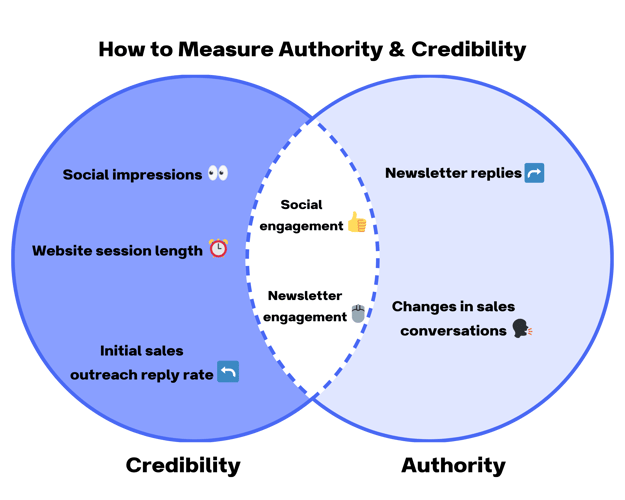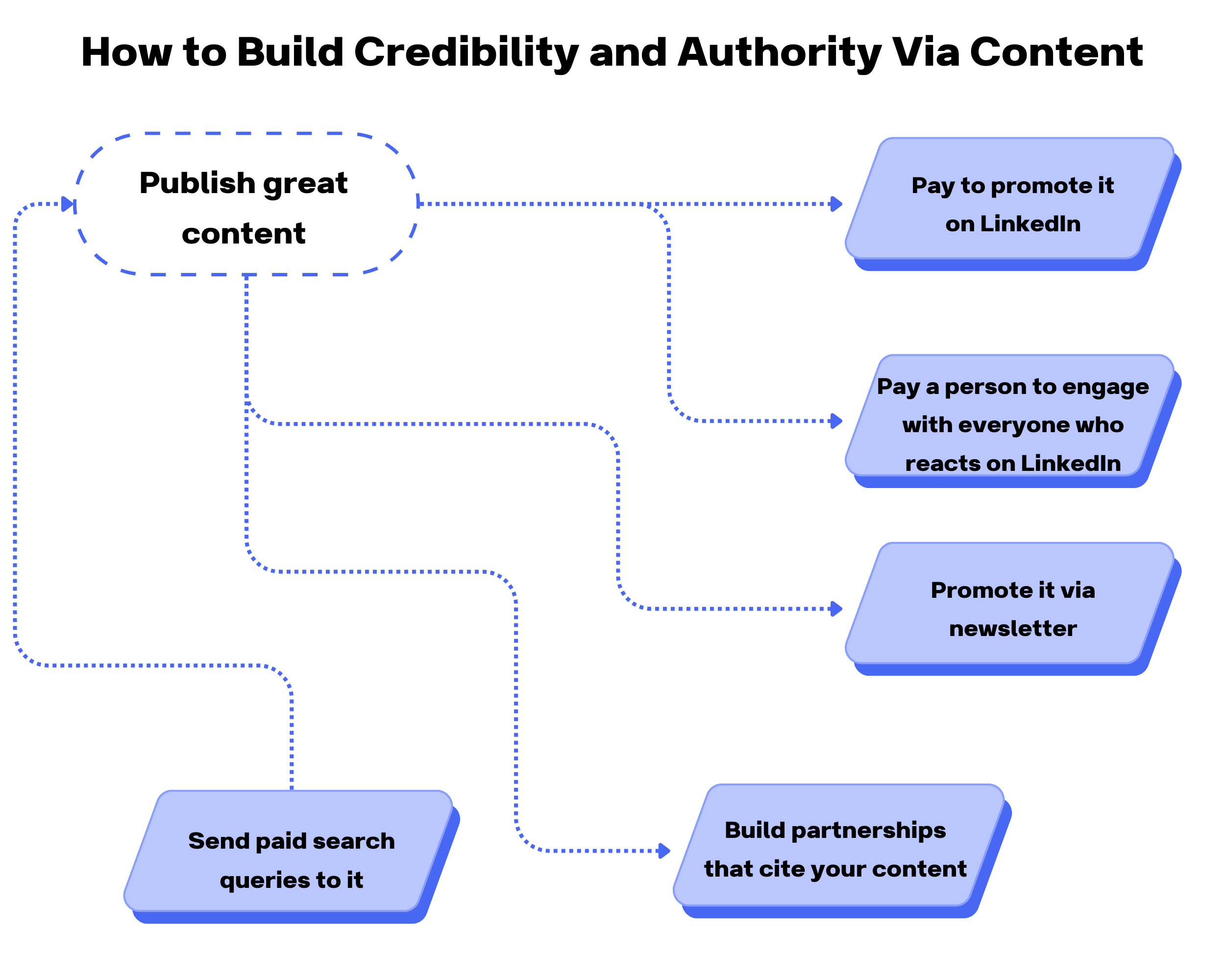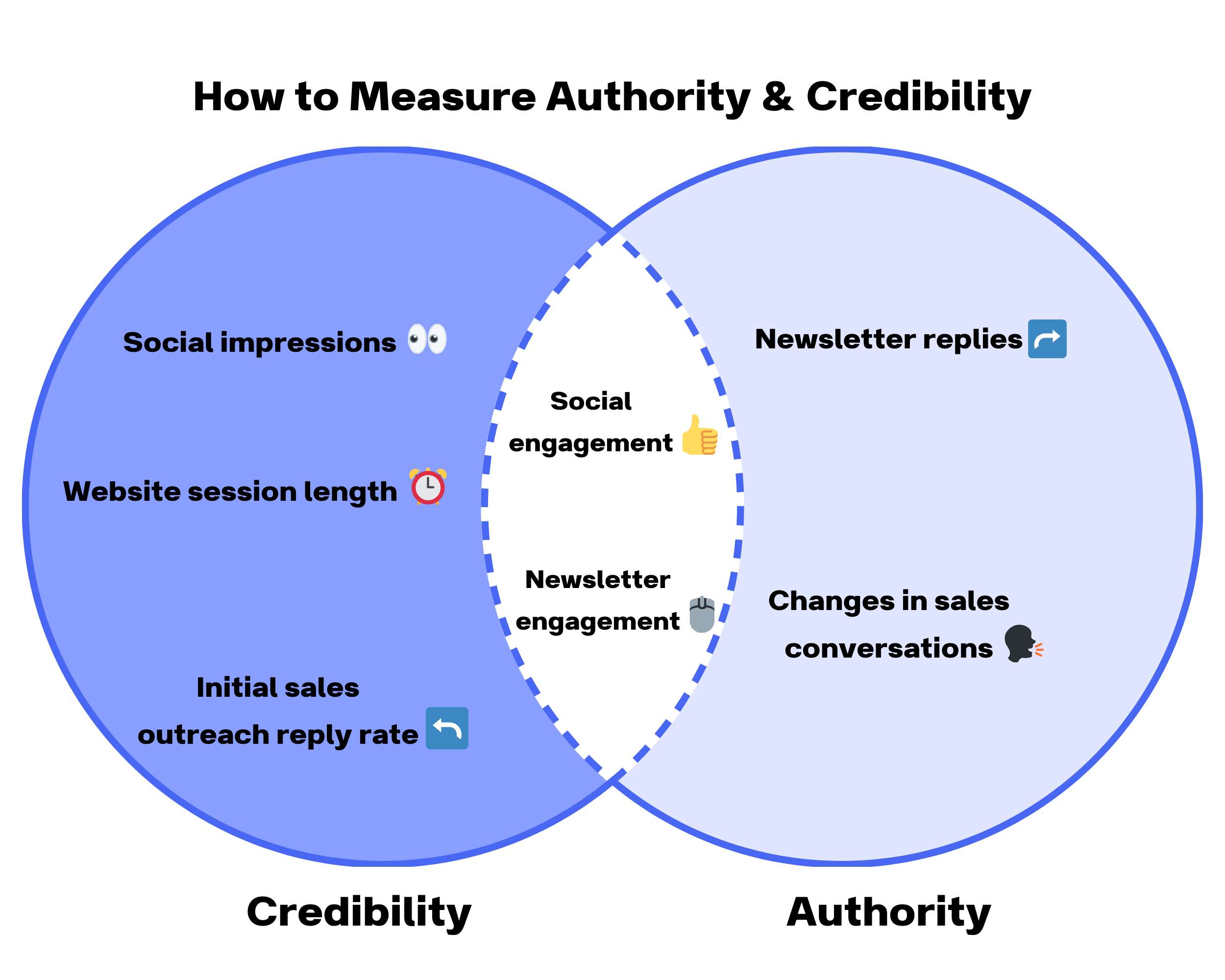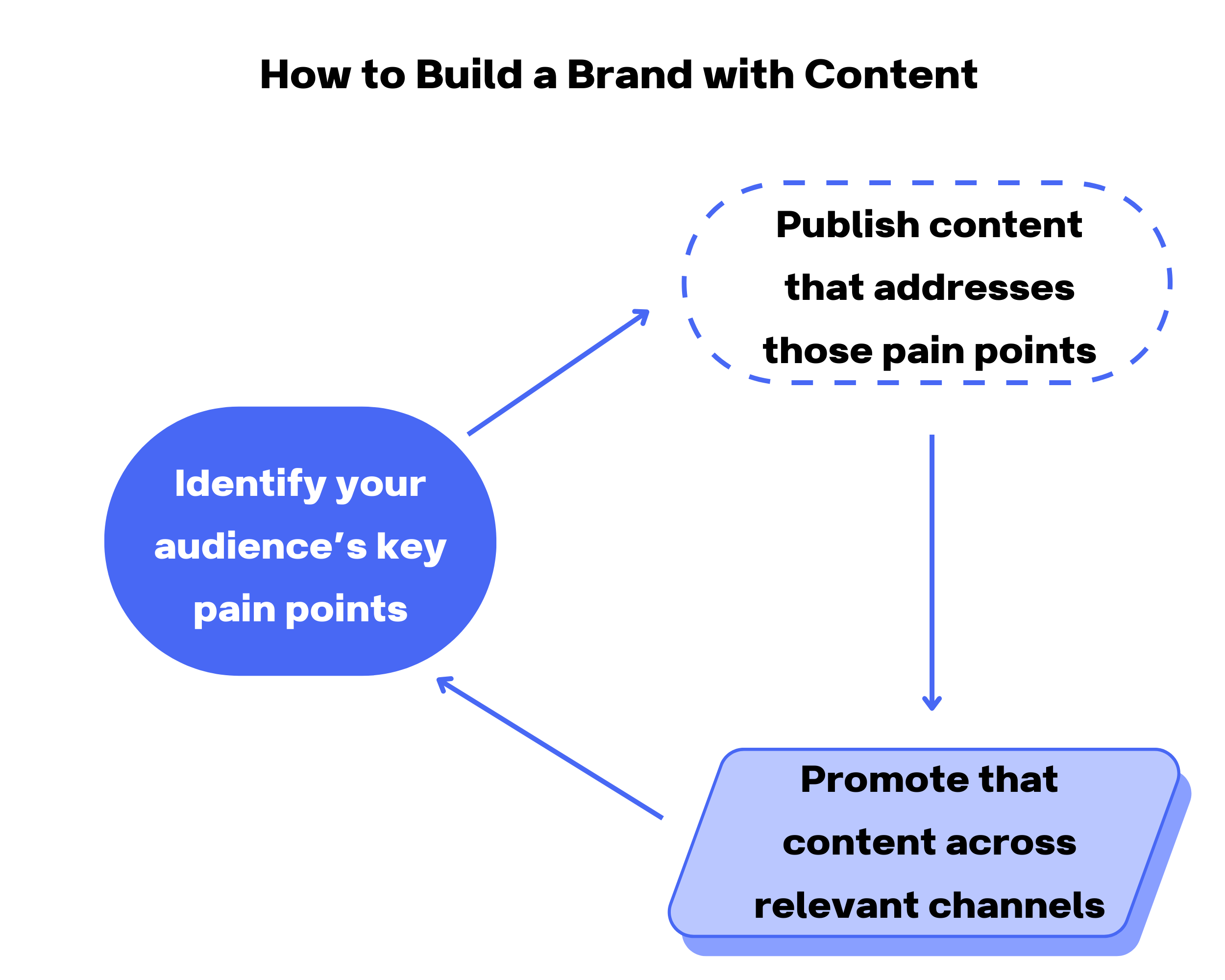How to Measure the Performance of Thought Leadership Content: 4 Frameworks

If your startup sells to enterprises, you know all about long sales cycles and decisions by committee. You know how thought leadership content can propel your organization forward throughout that process. (And if you don’t, pause and read this piece first.)
But maybe you’ve hit resistance from leadership when content marketing comes up during budget season. Maybe you’ve been asked why site traffic growth doesn’t look like a hockey stick. Maybe you now have to stake your reputation on an investment that may take several more months to prove its success.
That’s a tough position.
If you find yourself there, this blog post is for you. If you want to avoid ever finding yourself there, this blog post is also for you.
To write it, I spoke to three B2B content marketing veterans familiar with the challenges of selling to large businesses to get their take on how to measure the performance of thought leadership content. I boiled our thoughts down to four frameworks built for what you’re trying to do. Let’s take a look.
Measurement Framework 0: Drive Organic Traffic and Leads
Why is this Framework #0? Because it doesn’t work for B2B, and especially not B-to-large-B or B-to-enterprise. But because it’s the framework most people are most familiar with, you may get asked only about traffic and leads ahead of the next board meeting.
I’m including it here because I’ll be comparing the other frameworks to this one, so I want to make sure we’re all on the same page.
The basic premise of this content measurement framework is that more = better. More posts lead to more traffic, more engagement, more leads, and more sales. It works well for organizations that…
- Sell something visitors can buy during a site visit.
- Sell something at a low price point (i.e., one that a consumer can easily justify or that a businessperson can confidently put on their business card).
- Sell scalable products (e.g., SaaS or mass-produced objects).
For startups whose products fit the description above, content is a numbers game: attract enough people to the site, and some will enter the sales funnel. Over time, supported by other marketing and sales tools, a certain percentage will buy.
That’s great. But it’s not that useful to the work of B2B.
As content strategy consultant Bethany Suckrow put it, “SEO is table stakes for any kind of business you’re doing. But, in B2B, if you’re measuring only by SEO, you’re not telling the full story.”
How to measure performance of “the more, the merrier” content
I’m not going to get into it. Other people have done it far better than I could, so check out their resources (if you’re not already familiar):
- Hubspot’s guide to blogging metrics
- AHREFs’s guide to measuring SEO performance and results
- SEMRush’s guide to content marketing metrics
The problem with this framework for B2B
Because this is the best-known framework for measuring content performance, a lot of B2B content marketers are held to its standards. But by those standards, their work will almost certainly fail. Depending on the circumstances, they may be asked to pivot their strategy before they can show (definitive) results.
So. How do you measure the performance of B2B thought leadership content? The following four frameworks can help stave off SEO-style measurement demands. Whenever possible, introduce these performance measurement frameworks ASAP to set expectations about when and how your content investment will show its worth.
Measurement Framework 1: Raise Credibility and Authority
First, some definitions:
Credibility = This person (or brand) can be trusted on the topics they comment on.
Authority = This person (or brand) has extensive specialized knowledge and experience about the subject matter they engage with.
When B2B brands have credibility and authority, members of their target audience trust what they say, which means they can influence the decisions these audience members make.
And as marketing consultant Natalie Boike highlighted, Edelman’s latest Trust Barometer found that 63 percent of people worldwide buy from – and even advocate for – brands that share their beliefs and values (i.e., brands they trust).
If SEO performance is a numbers game, B2B content marketing is a targeting game.
That’s true for two reasons:
- There aren’t as many potential prospects for what you’re selling, so you can’t just publish great content, wait for Google’s algorithm to send you leads, and trust that enough will buy to justify your content investment.
- Timing matters. To be among the vendors a prospect considers, you have to be on their radar during the 83 percent of their buying journey when they’re doing independent research. That means you need a strategy for getting them what they need while they’re still open to influence.
Rather than aiming to maximize the total number of people who see a resource, the goal for credibility- and authority-building content is to maximize the odds that the right people see it enough times. This means there has to be a much bigger emphasis on the promotion side of the publish + promote content marketing equation.
Tactics that can help (see Figure 1):
- Publish content and pay to promote it on LinkedIn.
- Publish content and promote it organically on LinkedIn, then pay someone to engage with anyone in the universe of target audiences who reacts to it. (Here’s a step-by-step breakdown of how to make this work.)
- Publish content and spotlight it in a newsletter.
- Publish content and point highly relevant paid search queries to it.
- Pay for sponsored content at relevant industry publications (though I have a workaround in Framework 3 that lets you do this less expensively AND more impactfully).
- Build partnerships that include links, guest posts, social posts, reviews and shout-outs of your brand.
That last bullet point is worth digging into. Tracy Flack, integrated content strategist, emphasized the importance of collaborating rather than competing with other thought leaders in your space. “Look for other authoritative, credible sources in your space that want to partner with you,” she recommended. “Customers are looking for that credibility and this will help you build trust and increase your audience reach more than you can alone.”
It’s a brilliant strategy: if you’re looking for a new mechanic, for example, whose opinion would you trust more than another mechanic’s?
These partnerships can take many forms: linking to each other’s websites, highlighting each other’s ideas and work on social and during events, referring customers, etc.

Figure 1: The publish-promote dance for building credibility and authority via content
How to measure the performance of credibility- and authority-building content
To (approximately) measure credibility, track…
- Social media impressions and engagement: If your message resonates, people are more likely to engage. Thanks to the algorithms, this means more people see your content.
- Newsletter subscribers and engagement: Again, the more relevant your content, the more likely subscribers are to open your emails – and recommend your stuff to their peers (Natalie calls this “resonance” – how much your content resonates with your target audience).
- Length of website sessions: Don’t expect a tsunami of visits. But one important search signal is how long visitors stay on your site. When content resonates, visitors are more likely to hang around, which signals to Google that you’re doing well on Expertise, Experience, Authoritativeness, and Trustworthiness (EEAT).
- Response rate to initial sales outreach: The relationship here is correlative, not causal. But as your brand’s credibility grows, salespeople should note a higher response rate to initial outreach.
To (approximately) measure authority, track…
- Social media engagement (reactions, shares, comments): If people are willing to go on the record that they like your content, that’s a strong signal you’ve established authority in your space. Even better: those social signals boost your authority further.
- Social followers and newsletter subscribers: Interpret these (loosely) as “we like / trust this source.”
- Newsletter engagement: Opens are good. Replies mean you’ve said something that resonates and the respondent trusts you enough to engage directly. Forwards represent the all-powerful word of mouth.
- Changes in sales conversations (e.g., questions that come up less often, new questions being asked, shifting focus of conversations): The specifics here will depend on your baseline, what you’re selling, and a bunch of other things. You’ll have to coordinate closely with your sales team to get a sense for how conversations go today, then decide collectively what to measure to assess prospects’ trust in your brand’s expertise.

Figure 2: Metrics to measure credibility and authority
Note the key differences from measuring SEO content (which apply to all of these frameworks):
- Increasing leads and conversions is not a top priority. A lack of leads or conversions directly from content sources on its own is not proof of failure of content operating in this framework.
- Not all of these metrics are measurable via digital tools. For some, you will have to talk to people, which means you should have a system and schedule for having those conversations and reporting on them. Consider creating occasional surveys you submit to the sales team, for example, or to company reps who attend in-person events.
If you get pushback about valuing impressions (versus engagement), think of your own use of email and social media. You may not react to every bit of content you enjoy. But over time, the ideas and viewpoints in the content you subscribe to influence you.
Tracy explained it like this: “Value is what matters. To assess value, look at their feedback. Are people engaging by liking and sharing? By leaving positive or negative comments or reviews? Are they returning to your website after a first visit? Once you get someone through the door, how are you keeping them there? Are you bringing them back? And how do you plan to build a lasting positive relationship with them?”
Measurement Framework 2: Facilitate Sales
When customers have to talk to a real live person to buy your product or service, sales enablement content is invaluable – especially when sales conversations play out over months. What's more, this content helps salespeople deliver value from the first interaction.
Sales and marketing teams have to collaborate early and often to make sales enablement content work. Bethany’s suggestion (emphasis mine): “Bring together sales and marketing for conversations about the customer journey before you ever think about content.”
The cycle should look something like this (see Figure 3):
- Sales team has a need.
- Marketing team builds content to meet that need.
- Sales team shares said content with prospects.
- Prospects ask questions the content raises.
- Repeat.

Figure 3: Sales enablement content flow
As Natalie put it, sales enablement content “gives sales teams reasons to engage. Conversations are more fruitful. For cold leads, it can give the sales rep another reason to engage.”
I know what you’re thinking: there are only so many blog posts my sales team is willing to send prospects.
I hear you.
The idea here is not to flood prospects’ inboxes with blog posts; the idea is to find ways to repeatedly deliver value to those prospects. In some cases, yes, that might mean sending a blog post that answers a question more thoroughly than a salesperson could in a conversation.
In other cases, it might mean reaching out to a prospect to ask for a brief interview for a piece the marketing team is working on. “We’re working on a roundup of onboarding trends for 2024, and we know you’ve got a great system in place. We’d love to interview you for an upcoming piece we’ll be promoting to our 5,000-person email list.”
Um, hello.
Free publicity? That paints the prospect as an expert in their field? Who says no to that?
🚨VALUE ALERT 🚨
Not to mention all the excuses this will give you to follow up: with a draft for review, when the piece goes live, when you promote on social, when you hear great feedback from your network, and so on.
(Want an example? Here you go!)
Bethany recommended thinking of content as tools you give your sales team. Yes, you might have to invest thousands of dollars in producing a high-quality video testimonial from your best clients, she said, but if that video helps the sales team close even one contract worth hundreds of thousands of dollars, it’s an excellent investment.
How to measure the performance of sales enablement content
Start with qualitative questions that get at how the content impacted the relationship. You’ll have to customize these for your organization, but here are some starting points:
- Is the sales team using sales enablement content? If not, it’s probably not meeting their needs. This is a sign sales and marketing need to connect better.
- How are prospects responding to content? Positive responses = strong performance.
- How did the content affect the relationship? Did it help the prospect better understand your industry or offering? Did it lead to further questions that signaled they were getting more serious about making a purchase? Evidence of moving the conversation forward = strong performance.
Depending on how metrics-oriented your organization is, you can create rubrics for each question, then – voilà – assess each asset on its performance.
Don’t limit yourself to qualitative measures, though. If you’ve got the tools and bandwidth – and if the following are relevant to your sales process – consider also tracking quantitative measures like…
- How often do prospects download content assets?
- How does content impact the number and sentiment of prospect responses?
- How does the use of sales enablement content affect sales cycle length? How does it correlate with closed-won deals?
- What's the average LTV of content-supported customers vs. non-content supported customers?
- How often did your sales team send out your content?
Obviously, some of these won’t be knowable for a long time. But that’s the point: sales enablement content performs over a much longer time horizon than traffic-focused SEO content. Set these expectations from the start, and you’re halfway to success.
🌟Bonus 🌟: Don’t forget that content can also be used to boost customer retention. “Maybe you launched a new feature that solves a major customer pain point, but only five percent of customers are using it,” Natalie said, by way of example. “What content can you produce to [increase use] and therefore drive retention?” Even better: retention (and its financial benefits for your organization) is easy to track.
Measurement Framework 3: Fuel PR
Think of this framework as a way to feed two birds with one scone (thanks, PETA).
Briefly, the idea is:
💪Thought leadership content = good; but
🤔Measuring thought leadership content = hard; so
✅Stress-test thought leadership content via those with highly calibrated BS detectors (editors and journalists)
Here’s how it works (Figure 4):
- Publish compelling thought leadership content on your site.
- Pitch relevant target outlets related topics. Share a link to your content as evidence of writing chops and, you know, actual thought leadership on a relevant topic.
- When an editor bites, consider it validation that your content is on target for your audience. (Note: this is the workaround I mentioned in Framework 1. In some industry pubs, paid placements run north of $10,000, whereas one you get by pitching costs only your time. But if you need a ghostwriter, hit me up.)
(If you’re strapped for content resources, you can refrain from publishing the original piece on your blog and simply pitch that to industry publications.)

Figure 4: How to fuel PR with content
🌟 Bonus 🌟: This strategy expands your orbit of influence.
⚡Turbo mode ⚡: Pitch an editor the piece you wrote from interviews with prospects. This not only increases your odds of placing the piece but also increases the value you can deliver to prospects: increased exposure for their brands among a larger relevant audience.
How to measure the performance of media-fuel content
While all thought leadership content aims to build authority and credibility, a PR component accelerates things. Here’s why:
- Third-party coverage offers powerful validation for your leaders and brand.
- Third-party coverage helps expand awareness of your brand as well.
For B2B orgs, targeting PR efforts is hugely important. A profile in the New York Times may actually be less valuable than one in a niche publication that serves your industry.
To that end, it’s wise to rank target publications at the start of your journey and prioritize those you expect to have the biggest impact (whether or not they’re the ones with the biggest audience).
Metrics for media fuel include…
- Total number of placements by rank: E.g., 9 in Bucket A, 5 in Bucket B, 3 in C.
- Estimated target audience reach (if the publication doesn’t provide this information, tools like AHREFs can offer a proxy): When you’re targeting correctly, more reach = more relevant reach.
- Utilization of the placement: This can manifest in many ways, including…
- Social media promotion of your article (track views and engagement).
- Newsletter promotion of your article (track total distribution, opens, clicks, replies, and forwards).
- Use of the article in sales conversations.
- Impact of adding the publication’s logo to your website (e.g., increase in CTA clicks when relevant logos are present).
You can also track inbound links and traffic from media placements, but these are neither guaranteed (because too many people abused this as an SEO tactic) nor expected. Remember: B2B content is a long game, about building authority and credibility with a niche audience over time. Occasionally, a reader may be ready to make a purchase decision when they see your content, but most readers will not be.
Measurement Framework 4: Build the Brand
In B2B, brand building is less about creating deep emotional connections with customers (as it is in B2C) and more about ensuring that members of your target audience know who you are and understand what you do.
Our client Icon experienced the power of brand building about a year into their content marketing program: the CEO came back from a conference and said, stunned, “Everyone knows us now.”
The VP of client success chimed in with a similar story: on a recent client implementation, she didn’t have to explain the value of their software. “That never happens,” she said.
But, starting then, it did.
This is a huge moment for B2B brands, because it means your content is doing a lot of the work that sales reps used to do. It means your content assets are making it possible for customers to proactively sell themselves on your solution.
As Tracy noted, “People want information. This will help guide their decisions. If [your brand is] on the forefront of pure expertise and research, it will help drive decisions by capturing the attention of prospects who are much further down the conversion funnel.”
She went on to explain that “many people appreciate more detailed content (rather than vague and generic content). So by taking the time to explain and simplify complex topics and issues, you’ll gain a big advantage over other brands.”
This strategy can be particularly powerful for brands that have until now relied exclusively (or primarily) on outbound efforts.
Here’s a breakdown of how it works (Figure 5):
- Identify your target audience(s) and the pain points your solution addresses.
- Create content that addresses those pain points.
- Publish.
- Promote.
- Repeat.
You can (and should!) tap into the strategies outlined in the above sections to create this content: interview prospective customers for their perspective, pitch some of your pieces to the media, collaborate with sales to identify pieces most likely to move the needle, etc.

Figure 5: How to build a brand with content
How to measure performance of brand-building content
- Engagement on social. This is not a perfect indicator. But if you’re creating content that resonates with your target audience and investing in distribution on appropriate social channels, chances are your engagement will improve. (Note: I’m using “distribution” here rather than “promotion”; any meaningful impact from social media will include real, human-powered engagement with real social media users.)
- Prospects’ brand familiarity. To measure this as objectively as possible, create a rubric that measures specific things: e.g., what salespeople have to explain, which questions prospects ask, etc. Work with people in prospect-facing roles to help you build this rubric.
- Direct traffic to your site. Again, not a perfect indicator but it can be a directional data point used with other data points.
- Google trends tracker. If your brand name is unique enough, you can track Google search trends for branded searches. Be forewarned, though: if there's little to no monthly search for your brand name when you start, you may not have a big enough audience for this metric to register any growth.
- Customer awareness surveys. I don’t recommend this, though, because for a niche B2B audience, they’ll likely be time-consuming and EXPENSIVE (with questionable ROI).
- Behavior at conferences and during implementations. This may be a lagging indicator, but it’s excellent evidence that your messaging is breaking through.
2 Techniques That Benefit Any Content Strategy
There's a lot of overlap in the content strategies mentioned above. Realistically, your organization will probably need to measure in ways that combine elements of multiple frameworks.
Regardless of which direction you choose to go, though, any content strategy can benefit from doing two things:
- Embrace quality over quantity. In 2019, I advocated for those with limited content budgets to blow the whole thing on one high-value resource (#hottake, amirite?). That strategy could be even more valuable today, given ever-rising standards for quality and usefulness and the increasing ease of creating low-value content with generative AI.
- Get people from around your organization involved in content creation. The last thing you want your content to sound like is “marketing content.” So get SMEs involved. Get perspectives from around your organization. Speak to as many people – including customers – as you can. This will make your content stronger, more interesting, and more useful.
When you’ve committed to creating great content, choose a measurement framework to track your progress. This will set expectations with the folks who control the budget, which can be crucial for sustaining the program for as long as it takes to deliver meaningful results.
Still reading? Bless you. If you’ve made it this far, feel free to reach out with questions. I love nerding out on this stuff and would be happy to help you think through the best approach for your goals.







